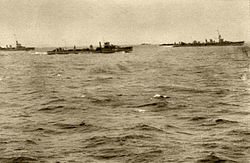British campaign in the Baltic (1918–19)
| Baltic Naval War | |||||||||
|---|---|---|---|---|---|---|---|---|---|
| Part of Russian Civil War, Estonian War of Independence, Latvian War of Independence | |||||||||
 British squadron in Koporye Bay in October 1919 |
|||||||||
|
|||||||||
| Belligerents | |||||||||
|
|
|
||||||||
| Commanders and leaders | |||||||||
|
|
|
||||||||
| Casualties and losses | |||||||||
|
|
|
||||||||
The British Campaign in the Baltic 1918–19 was a part of the Allied intervention in the Russian Civil War. The codename of the Royal Navy campaign was "Operation Red Trek". The intervention played a key role in enabling the establishment of the independent states of Estonia and Latvia but failed to secure the control of Petrograd by White Russian forces, which was one of the main goals of the campaign.
Launched in the wake of the Russian collapse and revolution of 1917, the purposes of Operation Red Trek were to stop the rise of Bolshevism, to protect Britain's interests, and to extend the freedom of the seas.
The situation in the Baltic states in the aftermath of World War I was chaotic. The Russian Empire had collapsed and Bolshevik Red Army, pro-independence, and pro-German forces were fighting across the region. Riga had been occupied by the German army in 1917 and German Freikorps and Baltic-German Landeswehr units were still active in the area. Estonia had established a national army with the support of Finnish volunteers and were defending against the 7th Red Army's attack.
The Russian Baltic Fleet was the key naval force available to the Bolsheviks and essential to the protection of Petrograd. The fleet was severely depleted after the First World War and Russian revolution but still formed a significant force. At least one Gangut-class battleship, as well as several pre-dreadnought battleships, cruisers, destroyers and submarines were available. Many of the officer corps were on the White Russian side in the Civil War or had been murdered, but some competent leaders remained.
...
Wikipedia
